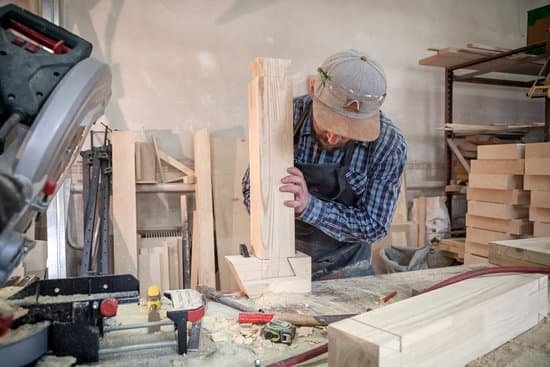Introduction- What is Butt Joint Woodworking?
Butt joint woodworking is a type of woodworking joinery that involves two pieces of material being joined together side-by-side. This type of joint does not require any kind of specialized hardware or fittings, meaning that it can be used for a wide variety of applications, from simple construction to complex projects. The butt joint operates on the principle that two flat surfaces pushed up against each other will naturally connect and provide strength and stability. To hold the two boards securely in place, nails, screws, dowels or glue are typically used. Thanks to its simplicity and versatility, the butt joint is one of the most commonly utilized methods of joining materials in woodworking projects.
Benefits of Butt Joint Woodworking
Butt joint woodworking is a basic and versatile type of joinery used in many furniture projects and carpentry projects alike. Its technical name is a simple butt joint, but it can be also referred to as a “butted joint” or just a “butt”. It is the most basic type of woodworking joinery technique; two pieces of wood with straight edges are simply aligned together, end-to-end, and secured. This type of joinery can be executed with several different methods, ranging from screws and nails to biscuits or even dowels.
The benefits of butt joint woodworking include its ease of assembly, great strength and security. When done correctly, the joint forms an incredibly strong bond between the two pieces of wood being joined ” creating one solid piece instead of two separate ones. In addition to this strength, butt joints are incredibly simple to assemble since they only require minimal tools like a saw, drill, jig and clamp. Screws are the simplest method for joining pieces with But joints; they provide great physical stability while also supporting extra weight applied to the joined piece without coming apart or failing over time. Finally, it’s often possible to hide any imperfections in the joints by using glue or filler such as putty/wood putty so any gaps between pieces aren’t noticeable when looking at the structure after assembly is complete.
Types of Butt Joints-Exploring Common and Less Common Butt Joints
Butt joint woodworking is a form of carpentry or furniture making which uses joining techniques to create sturdy, cohesive products. Butt joints are used in furniture constructing and cabinetry as they are one of the easiest and simplest forms of j oining pieces together.
There are several types of butt joint woodworking, including more common methods such as dowel joints, biscuit joints, and pocket hole joinery, as well as less common types like the miter butt joint, the sliding dovetail joint, and the mortise & tenon joint. The dowel joints use wooden dowels that are drilled into both end pieces being joined together to create a secure connection between them. Biscuit joints make use of pre-manufactured oval biscuits that slides into slots cut across the grain in each piece being joined. Pocket hole joinery requires a drill bit to create pockets for screws to be installed into each host piece in order to keep them connected.
The miter butt joint is formed by cutting both ends of two host pieces at an angle before joining them using glue or another type of adhesive. Sliding dovetail joints require the creation of dovetailed shaped slots in one or both host pieces before joining them using an adjustable clamp or screwdriver. Finally, mortise & tenon joints form a strong structure by combining a rectangular mortise opening on one part with an inserted tenon tongue on another part. Pencil marks indicate where cuts should be made for exact results.
Tips for Choosing the Right Butt Joint for Your Project
Butt joints are one of the simplest woodworking joints and are used in everything from furniture to cabinets. They are also incredibly versatile, as they can be easily adjusted depending on the type of joint desired and the materials being used. When selecting the right butt joint, there are several factors to consider:
• Material: Consider the type of wood or other material being used to create the piece. Different types of wood require different joinery techniques, so make sure a butt joint is suitable for your project.
• Strength: The strength of a butt joint depends in part on how tight it is when secured with nails or screws. Test different methods to see which provides adequate strength for your needs. Also account for any potential shrinkage in the future due to humidity changes by adding extra fasteners if necessary.
• Tooling: Depending on what tools you have available, certain types of butt joints might be more feasible than others. Be aware that some joinery requires specialized saws and fixtures that may go beyond what basic workshop tools can provide.
• Aesthetics: Butt joints are usually seen from one side only and their appearance should coordinate with an overall design goal. To do this, several variables such as filler strips or even mortise-and-tenon work might be necessary to achieve a cleaner look in exposed areas.
Advantages and Disadvantages of Butt Joints
Advantages of Butt Joint Woodworking:
1. Butt joints are the easiest to construct, making them ideal for novice woodworkers.
2. Butt joints require minimal material and use no specialized tools or accessories, so they can be constructed quickly and easily with a saw and hammer.
3. As they are simple in design, they are very strong and capable of securely supporting large loads with minimal effort on the part of the woodworker.
Disadvantages of Butt Joint Woodworking:
1. Without additional bracing to prevent movement, butt joints are not as strong in terms of torsional stress as other joinery methods such as dovetail or dowel jointing.
2. Additionally, without any sort of mechanical fastener such as nails or screws, their strength depends almost entirely on the quality of the glue used to hold them together; so if the joint fails it is difficult to repair without completely disassembling it first.
3. Aesthetically speaking, butt joints often lack appeal due to their noticeably rectangular appearance when cut into two pieces of wood stacked against one another at a 90 degree angle
Preparation and Techniques for Installing Your Butt Joint
Butt joint woodworking is an important skill to learn, as it is a technique used to join two pieces of wood at their ends. The basics of the butt joint are fairly straightforward; you simply place the ends of the two pieces flush against each other and secure the connection with glue, screws or nails. However, there are certain preparation steps and techniques that can make for stronger, longer lasting joints.
One essential element of creating a strong butt joint is to make sure both surfaces are level and even before securing them together. You can ensure this by using clamps or a flushing tool to level out small discrepancies in the surfaces. Additionally, making sure all cut edges on the two pieces are straight and that there are no gaps between them can prevent long-term problems down the road. It’s also important to use the right type of adhesive when joining the two pieces together; epoxies, polyurethane glues or polyvinyl acetate (PVA) work well as they form strong bonds while allowing flexibility over time.
You also need to get your fastening tools ready before installing a butt joint. If you choose to use screws, pre-drill pilot holes through both pieces in order to reduce splitting or cracking along any grain lines in one of the pieces ” especially if you’re working with softer woods like pine. To provide additional strength for heavy-duty projects, consider reinforcing your butt joints with metal plates or angles connected with rivets or other hardware. Lastly, always allow ample time for your glue or adhesive to cure so that it can fully establish its bond with both sides of the joint before taking full force loads from whatever you’re constructing!
Tips for Perfecting Your Butt Joints
Butt joint woodworking is a fundamental technique and key skill for any woodworker. A butt joint is simply two pieces of wood that are butted up to one another without an overlap or mortise and tenon. When done correctly, this type of joint can create strong connections between pieces and make completing a project much easier. Perfecting your butt joints requires patience and attention to detail. Here are some tips to help you get it just right:
1. Pick the right woods: Ensure the grain runs in the same direction on both surfaces of the butt joint, otherwise, the connection might not be as secure as it could be.
2. Measure twice, cut once: Taking precise measurements to minimize errors is still something worth doing when creating a butt joint; even fractions of an inch can affect how tight the end result will fit together.
3. Test before assembling: Fitting components together as you go makes more sense than trying to adjust them afterwards, so make sure you check everything several times before moving on too quickly.
4. Glue up firmly: Rubbing down excess squeeze-out with your finger or a damp cloth should help make sure your parts are tightly stuck together; excess glue won’t do anything other than compromise strength at the point of adhesion.
5. Apply clamps carefully: Make sure pressure from clamps is evenly distributed across both surfaces being joined; using cauls or flat blocks in conjunction with clamps can help ensure maximum force has been applied where necessary for a successful connection..
Materials Needed for the Perfect Butt Joint
Butt joint woodworking is a common and simple way to join two pieces of wood together. It involves using the end of one board to align with the end of another board, creating a flat and secure connection. Projects made with butt joints can be used for basic construction for many furniture pieces and other objects. To ensure that the butt joint is strong and secure, there are a few materials that are necessary to have on hand.
First, clamps will be needed to hold the boards in place while they are being fastened. Different types of clamps can come in handy depending on what type of surface the butt joint will be placed on (i.e., edges or faces). This could include bar clamps, corner clamps, or C-clamps. Another important material will be the screws used for fastening the boards together; longer screws going into two-by-fours work best for stronger support. Drill drivers aid in making sure that screw placement is correct, since pre-drilling holes ensures less chance of splitting or cracking. Finishing supplies such as saws, sandpaper and wood putty are also helpful when finishing up a project with a butt joint; these items make sure that all uneven seams and rough edges are smooth and even prior to staining or painting. Acquiring quality materials like these ensures a successful outcome when working with butt joints!
Tools Needed for an Effective Butt Joint
Butt joint woodworking is a technique used to join two pieces of wood together. This joint is common in carpentry, cabinet making and furniture construction. To make an effective butt joint, there are a few essential tools that are needed.
The first tool you need for butt jointing is a saw such as a miter saw, table saw, or jigsaw. This will allow you to cut the pieces of wood to the same length and at the correct angles. A router can also be used to create precisely sized and angled cuts.
In addition to a saw and router, it is important to have clamps on hand when butt jointing. Clamps help keep the wood together while you are working on it so that everything stays in place until the glue dries.
Another important tool for butt joints is sandpaper and/or a hand plane. These tools work great for removing any discrepancies between each piece of wood before using glue or screws. This will ensure better alignment and contact between each piece of material being joined together with the butt joint.
A drill is also handy for attaching screws into the connecting material before adding glue, which will add extra stability to your jointed pieces of wood after the glue sets completely harden. Finally, an appropriate type of glue must be chosen”a waterproof and quick-setting polyurethane adhesive works best for most butt joints because of its strength and versatility in varying weather conditions or moisture levels in your project’s environment
Safety Considerations for Butt Joint Woodworking
Butt joint woodworking can be a great hobby or even a successful business, but there are important safety considerations to keep in mind when working with wood. First and foremost, make sure you wear the appropriate protective gear. This includes safety glasses, breathing protection, and protective clothing like long pants and closed-toe shoes, as well as gloves. Hearing protection is also recommended if you will be using loud power tools.
Additionally, take care to read all of your tool’s instruction manuals prior to use in order to safely operate the machine and understand any warning signs or maintenance requirements that must be followed for optimal performance. This may mean that you need specialized training for certain machines before attempting to use them correctly or safely. Finally, always ensure that your work area is free from tripping hazards such as cords or small objects that could potentially cause an accident. Make sure that there is plenty of light so you always have a clear line of sight while working on projects.
Conclusion
Butt joints are a fundamental woodworking skill that any woodworker should learn and master. They are the most basic type of joint available in woodworking, allowing for two pieces of wood to be joined together without the need for fasteners, hardware, or adhesives. As such, butt joints provide a simple but effective way to construct furniture and DIY projects. Furthermore, there is great versatility with butt joints – they can be used as end-to-end connectors as well as varying angles to create T- or L-shaped frames. This versatility allows for a greater range of applications than other types of joinery and makes it easy to quickly prototype and build intricate designs. Additionally, because they do not require additional materials beyond the two connecting pieces of wood, butt joints are one of the most cost and labour efficient methods when creating wooden objects.
Ultimately, mastering butt joint techniques is an incredibly important milestone in any beginner’s journey into becoming an accomplished woodworker. A good start would be to practice with scrap pieces of lumber before attempting anything more complex and invest in some quality clamps to ensure a reliable connection between two adjoining surfaces. With just a little bit of practice and dedication you will soon find yourself creating strong and steadfast furniture frames with your very own handmade butt joints!

Hi everyone! I’m a woodworker and blogger, and this is my woodworking blog. In my blog, I share tips and tricks for woodworkers of all skill levels, as well as project ideas that you can try yourself.





